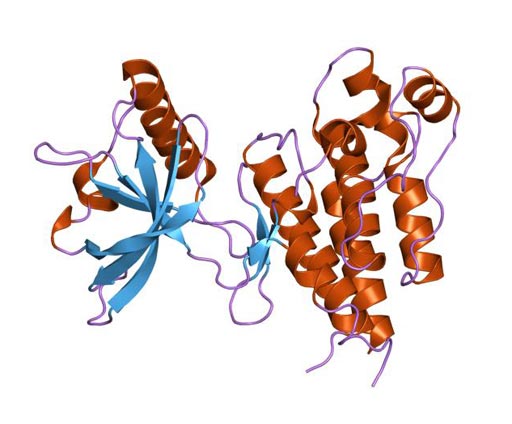Targeted Microbubbles Enhance Ultrasound Detection of Malignant Tumors
By LabMedica International staff writers
Posted on 11 Apr 2017
By combining standard ultrasound technology with a novel type of targeted microbubbles, cancer researchers have developed a sensitive method for detecting malignant tumors that could reduce the number of biopsies needed to differentiate them from benign growths.Posted on 11 Apr 2017
Investigators at Stanford University prepared one to four micron diameter phospholipid microbubbles containing a mixture of perfluorobutane and nitrogen gas that were labeled with kinase insert domain receptor (KDR) protein. The result was a class of targeted contrast microbubbles (MBKDR) that was targeted at KDR, one of the key regulators of neoangiogenesis in cancer. KDR is found on tumor blood vessels but not in healthy tissue.

Image: A representation of the molecular structure of KDR (kinase insert domain receptor) protein (Photo courtesy of Wikimedia Commons).
The investigators designed a study to assess whether ultrasound using MBKDR was safe and would allow assessment of KDR expression using immunohistochemistry (IHC) as the gold standard. They injected MBKDR intravenously into 24 women (age 48 to 79 years) with focal ovarian lesions and 21 women (age 34 to 66 years) with focal breast lesions. Ultrasound analysis of the lesions was performed starting five minutes after injection for up to 29 minutes. Blood pressure, ECG, oxygen levels, heart rate, CBC, and metabolic panel were obtained before and after MBKDR administration. Persistent focal MBKDR binding by ultrasound imaging was assessed. Patients then underwent surgical resection of the target lesions, and tissues were stained for CD31 and KDR by IHC.
Results revealed that ultrasound imaging with MBKDR was well tolerated by all patients without safety concerns. Among the 40 patients included in the analysis, KDR expression on IHC matched well with imaging signal on ultrasound imaging in 93% of breast and 85% of ovarian malignant lesions. Strong KDR-targeted ultrasound signals were present in 77% of malignant ovarian lesions, with no targeted signal seen in 78% of benign ovarian lesions. Similarly, strong targeted signals were seen in 93% of malignant breast lesions with no targeted signal present in 67% of benign breast lesions.
"The difficulty with ultrasound right now," said first author Dr. Jürgen Willmann, professor of radiology at Stanford University, "is that it detects a lot of lesions in the breast, but most of them are benign. And that leads to many unnecessary biopsies and surgeries. To decrease those unnecessary biopsies and surgeries would be a huge leap forward. We could make ultrasound a highly accurate screening technology that is relatively low cost, highly available, and with no radiation. And since ultrasound technology is accessible almost everywhere, he said, the technology could potentially help patients all over the world."
The targeted microbubble technique was described in the March 14, 2017, online edition of the Journal of Clinical Oncology.













